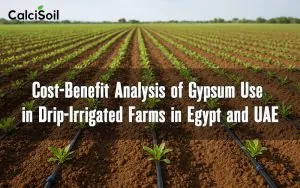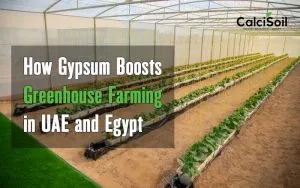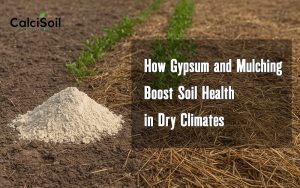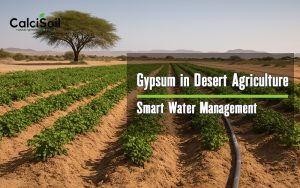
Agricultural gypsum, available in both powder and liquid forms, serves as a valuable soil amendment, each with distinct characteristics and application methods.
Agricultural Gypsum Powder
Gypsum powder is a natural mineral composed primarily of calcium sulfate. It is widely used to improve soil structure, enhance nutrient management, and increase water retention. Key benefits include:
Soil Improvement: Gypsum helps break down heavy clay soils, improving aeration and moisture retention, which is beneficial for plant roots.
Nutrient Source: It provides essential nutrients, particularly calcium and sulfur, which are vital for plant health and growth.
Application Method: Typically, gypsum powder is spread evenly across the soil and mixed into the top 6-12 inches. Recommended application rates range from 20 to 30 pounds per 1,000 square feet, adjusted based on specific soil conditions.
Timing: It is best applied in early spring or fall for optimal results during the growing season.
Liquid Gypsum
Liquid gypsum, often marketed as micronised gypsum, offers a more convenient application method compared to its powdered counterpart. Its advantages include:
Ease of Application: Liquid gypsum can be sprayed directly onto the soil or foliage, minimizing dust and allowing for more precise placement. This form is particularly useful for large areas or when quick application is necessary.
Higher Surface Area: The micronisation process increases the surface area, enhancing the effectiveness of the gypsum in soil conditioning.
Application Rates: For home gardens, a common dilution is 45 mL of liquid gypsum per 9 L of water, applied at a rate of 1 liter per square meter. For larger agricultural applications, rates can vary from 10 to 50 L per hectare depending on the specific needs of the soil.
Storage and Handling: Liquid gypsum must be stored properly to prevent microbial contamination and should be used within a certain timeframe after opening to maintain its effectiveness.
Which type of gypsum is more effective for improving soil structure?

Both powdered and liquid gypsum are effective for improving soil structure, but their effectiveness can vary based on application methods and specific soil conditions.
Effectiveness of Gypsum for Soil Structure Improvement
Gypsum Powder:
Gypsum powder is traditionally used to enhance soil structure, particularly in clay-heavy soils. It works by displacing sodium and magnesium ions on soil particles with calcium, promoting flocculation and improving soil aggregation. This leads to better aeration, drainage, and root penetration.
Studies indicate that high application rates (up to 27 tons per acre) combined with deep tillage can significantly improve soil structure by reducing sodium saturation and enhancing aggregate formation.
Liquid Gypsum:
Liquid gypsum, while also effective, is often preferred for its ease of application. It can penetrate the soil more quickly and uniformly than powdered gypsum, which may require mechanical incorporation to be effective.
The micronisation process of liquid gypsum increases its surface area, potentially enhancing its effectiveness in improving soil structure more rapidly than powdered forms.
Comparative Effectiveness
Application Speed: Liquid gypsum may offer quicker results due to its ability to be applied directly and absorbed by the soil without the need for tillage, making it suitable for immediate soil conditioning.
Long-Term Impact: Powdered gypsum may provide more sustained benefits when properly incorporated into the soil, especially in cases requiring significant structural improvement over time.
Plants Benefiting from Powdered Gypsum
Certain plants may benefit more from powdered gypsum compared to liquid gypsum, particularly those that require deeper soil amendments or have specific nutrient needs that are better addressed through the gradual release of nutrients. Here are some plants that can particularly thrive with powdered gypsum:
Vegetable Gardens: Many vegetables, especially those grown in heavy clay soils, benefit from the structural improvements provided by powdered gypsum. It helps to break up compacted soil, improving drainage and root penetration. Crops such as tomatoes, peppers, and carrots can see enhanced growth and yield.
Brassicas: Plants like broccoli, cabbage, and cauliflower require sulfur for optimal growth. Powdered gypsum provides a steady release of sulfur, which is essential for chlorophyll formation and overall plant health.
Alliums: Onions and garlic are known to thrive with the addition of gypsum. The calcium and sulfur in powdered gypsum help improve bulb development and flavor.
Lawns: Gypsum is often used in lawn care to improve soil structure, especially in compacted or clay-heavy soils. It promotes better drainage and root development, leading to a healthier lawn.
Fruit Trees: Trees such as apples and citrus can benefit from the gradual nutrient release and improved soil structure provided by powdered gypsum. This helps in root establishment and overall tree health.
Plants Benefiting from Liquid Gypsum
Canola: Liquid gypsum can improve the availability of sulfur, which is crucial for canola crops. The application of liquid gypsum enhances nutrient uptake and can lead to better yields.
Alfalfa: This legume is known for its high sulfur requirements. Liquid gypsum helps in meeting these needs, promoting better growth and higher forage quality.
Peanuts: Liquid gypsum has been shown to increase the yield and quality of peanuts. It provides calcium and sulfur, which are essential for proper development and can help reduce aflatoxin levels in the seeds.
Tomatoes: While tomatoes can tolerate gypsum in both forms, liquid gypsum’s quick absorption can help improve overall plant health and fruit quality, especially in soils deficient in sulfur.
Groundnuts (Peanuts): Similar to other legumes, groundnuts benefit from the calcium and sulfur provided by liquid gypsum, which can enhance germination and reduce certain stress factors.
Conclusion
Both forms of gypsum can effectively improve soil structure, but the choice between powdered and liquid gypsum should depend on specific agricultural practices, soil conditions, and the desired speed of application. For immediate effects and ease of use, liquid gypsum may be more advantageous, while powdered gypsum is often preferred for long-term structural improvements through deeper soil incorporation.







